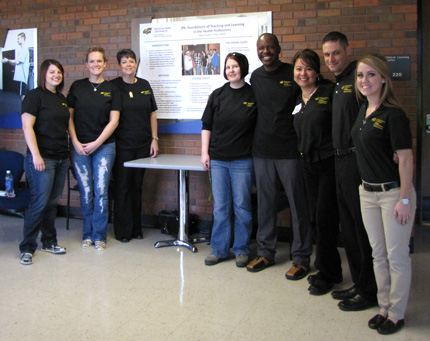As a nurse sent to the Dominican Republic in 1998, Mary Koehn says the labels and hierarchies between doctors and nurses, patients and families, quickly became insignificant.
Koehn, associate dean of Wichita State’s College of Health Professions, says in the impoverished nation, working together and pooling resources was the only way to get the job done and help patients get well.
It’s a system Koehn hopes to model as this fall the college begins phasing interprofessional education (IPE) initiatives into its curriculum. Koehn says IPE, recently endorsed by the World Health Organization, encourages students going into various health care sectors to work together toward patient-centered care.
“There is research to support that working as a team, you get better health care outcomes,” Koehn says. “It makes sense if we’re practicing in teams, we really need to be educating them in teams in the first place. I’m hoping we will graduate students who will come out of this with a better understanding of the roles of people in other professions, and they will be willing to work as a team.”
Koehn says in the past, health care practitioners trained and worked in silos, often leading to breakdowns in communication. The new IPE initiative aims to overcome such barriers by producing opportunities for professionals from various sectors to work together.
For example, a pilot program last year brought together students from both WSU School of Nursing and KU School of Pharmacy to provide flu shots at Wichita’s Guadalupe Clinic. Through the experience, she says students discovered subtle differences in how they’d been trained to give shots.
“What they discovered is they’d been taught a little different how to do it,” she says. “They had some nice discussions about technique.”
These types of discussions and collaborations are what Koehn hopes to promote through the new program, which will expect all degree-seeking students in the college to participate in at least one IPE activity during the academic year. Faculty will be asked to integrate IPE concepts into existing classes.
Developing the program
The program is the product of more than two years of planning and jives with national and international moves toward interprofessional practice, Koehn says. Recently, local health care providers such as Via Christi Hospitals in Wichita have moved toward similar systems of “shared decision making,” according to the Wichita Eagle.
Koehn says the biggest challenge has been moving students and faculty into a new mindset. The college has implemented training for faculty, who she says were largely educated in the silo mentality. However, the reception has been overwhelmingly positive, she says.
“Honestly I think our faculty all understand it conceptually,” she says. “You just have to figure out how to do it. I’m just so proud of what our faculty have done to really move this along.”
Victoria Mosack, WSU School of Nursing associate professor, says she believes IPE creates opportunities for students to learn from each other and form professional relationships they can carry into the real world.
“I think that we need to be willing to struggle through the interprofessional experience,” Mosack says. “I love to see students communicating with one another when such contact would have been difficult without the incorporation of purposeful IPE learning strategies.”
Brandy Jackson, WSU School of Nursing undergraduate program director and clinical educator, says students who have participated in past IPE activities give such experience high marks.
Ultimately, though, she says the IPE’s biggest winner is the patient.
“Simply, this is hard work, but the benefit to patients is what matters,” Jackson says. “Patient care is a team sport; it really always has been. Just like a sports team practices together, health care teams must do the same.”


